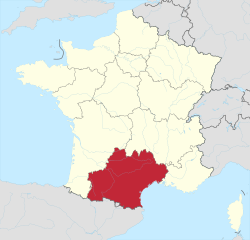Occitania
| |
|---|---|
 | |
|
| |
 | |
| Coordinates: 43°42′29″N 1°03′36″E / 43.708°N 1.060°E | |
| Country | France |
| Prefecture | Toulouse |
| Departments | 13
|
| Government | |
| • President of the Regional Council | Carole Delga (PS) |
| Area | |
• Total | 72,724 km2 (28,079 sq mi) |
| • Rank | 2nd |
| Population (2021)[1] | |
• Total | 6,022,176 |
| • Density | 83/km2 (210/sq mi) |
| Demonym(s) | Occitan(s) (masc.), Occitane(s) (fem.) (fr) |
| GDP | |
| • Total | €181.273 billion |
| • Per capita | €30,900 |
| Time zone | UTC+01:00 (CET) |
| • Summer (DST) | UTC+02:00 (CEST) |
| ISO 3166 code | FR-OCC |
Occitania[3] (French: Occitanie [ɔksitani] ; Occitan: Occitània [utsiˈtanjɔ]; Catalan: Occitània [uksiˈtaniə]) is the southernmost administrative region of metropolitan France excluding Corsica, created on 1 January 2016 from the former regions of Languedoc-Roussillon and Midi-Pyrénées. The Council of State approved Occitania as the new name of the region on 28 September 2016, coming into effect on 30 September 2016.[4]
The modern administrative region is named after the larger cultural and historical region of Occitania, which corresponds with the southern third of France. The region of Occitania as it is today covers a territory similar to that ruled by the Counts of Toulouse in the 12th and 13th centuries. The banner of arms of the Counts of Toulouse, known colloquially as the Occitan cross, is used by the modern region and is also a popular cultural symbol. In 2021, Occitania had a population of 6,022,176.
- ^ "Téléchargement du fichier d'ensemble des populations légales en 2021" (in French). The National Institute of Statistics and Economic Studies. 28 December 2023.
- ^ "EU regions by GDP, Eurostat". Retrieved 18 September 2023.
- ^ "Presentation of the Occitania / Pyrenees-Mediterranean region". www.tourism-occitania.co.uk.
- ^ Décret n° 2016-1264 du 28 septembre 2016 portant fixation du nom et du chef-lieu de la région Occitanie (in French)

